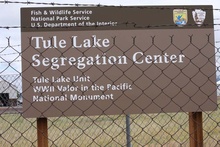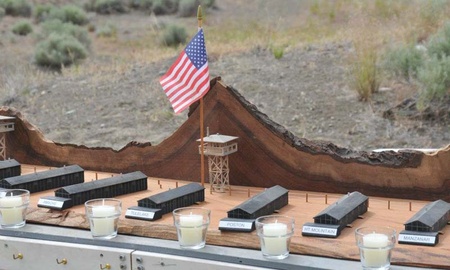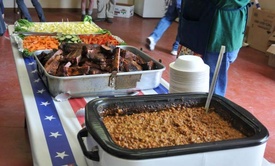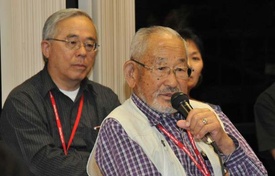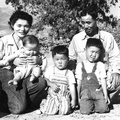My whole family was imprisoned for almost four years in America’s concentration camps by the federal government during and after World War II. Over two years of their incarceration was spent at the worst of the War Relocation Authority (WRA) prisons, the Tule Lake Segregation Center in northern California.
In 1943, the WRA decided to set up one of the ten prisons as a “segregation center” because all of the prison camps had a vocal minority who continually protested their incarceration and the wretched conditions in the prisons. In order to separate the protestors from the general prison population, the government devised a notorious questionnaire that asked adult inmates to declare their loyalty to the U. S., agree to serve in the military (for draft age males), and forswear any allegiance to the emperor of Japan. Any answers that were less than unqualified “Yes-Yes” or refusal to answer the questions resulted in a one-way ticket to the newly designated segregation center at Tule Lake. Since my father wanted to repatriate back to Japan, he was automatically put on the list. The rest of the family went with him: my mother, brother, grandparents, and my aunt and her family.
To this day, the former inmates at Tule Lake are regarded by many in the JA community as “troublemakers” or “disloyal”. Their stories have been marginalized and ignored for decades because they contradicted the accepted narrative of JAs as a “model minority” that did not complain when abused by their government. The Tule Lake pilgrimages during the last four decades have gradually gotten former inmates to talk about why they protested, why they answered less than “Yes-Yes” to the loyalty questions, and why they renounced their American citizenship. As a descendant of former Tule Lake inmates and a Museum docent, I wanted to further explore this dark chapter in American and JA history and learn first hand why inmates made the decisions that resulted in their transfer to Tule Lake. The following is a brief summary of my pilgrimage experience.
My overall impression of the pilgrimage was one of professionalism and inspiration. Professionalism because the event was planned so well, contained many mini-programs and workshops that were excellent, and packed so much useful information into just 4 days, including the bus rides to and from the airport. Inspiration because of the welcoming and friendly atmosphere, plus the heart-wrenching stories from former inmates who talked about their experiences of six decades ago.
The bus rides: The five plus hours each way from Sacramento Airport were filled with information from the bus monitors about Tule Lake, recollections from several former inmates, and videos that showed the devastating impact the experience had on many in the JA community. One could still feel the stigma that many former inmates have of their segregation at Tule Lake.
The Facilities and Meals: Most attendees stayed in the spartan college dorms. Common bathrooms and showers gave only a small inkling of what the Tule Lake inmates had to endure. The cold water in the men’s showers was a nice touch! Those lucky enough to reside in the new student apartments got air conditioning and semi-private quarters! The bus bentos were great, but the meals at the college cafeteria can best be described as plentiful, but college cafeteria quality. The BBQ put on by the Butte County Volunteer Fire Department was super!
Intro Program: The introductory program set the right tone for the whole pilgrimage. War resisters, No-No’s, and renunciants were honored for exercising their rights as American citizens to peacefully protest the violation of their civil rights. The atmosphere was electric when they were asked to stand and the audience burst into prolonged applause. All attendees were very friendly and open with each other throughout the four days.
Tule Lake Tours: The memorial service that began the day was very moving and presented further evidence of how JA’s were disrespected at Tule, even in death: after the war, the cemetery was desecrated by bulldozers mining the “prime” gravel on the cemetery grounds where a large pit now stands. The tours of the main prison grounds, the jail/stockade area, and Camp Tule Lake (former CCC camp turned into a mini-prison) were shocking. The narrative by National Park rangers and former inmates at both the stockade/concrete jail and Camp Tule Lake sites pulled no punches in describing the horrendous conditions in both facilities: beatings, harassment, psychological trauma and torture, gross overcrowding, etc.
Inmate Recollections: Former inmates described their experiences before, during, and after their Tule Lake incarceration. Some described gross mistreatment by the government that resulted in their decisions to either answer “No-No” to the loyalty questions or refusal to answer them at all. The consequences were severe: transfer to Department of Justice Internment prisons, renunciation, as long as 5 years imprisonment, and eventual deportation. Others described horrific conditions in post-war Japan that made living a matter of basic survival. Some described the pressures by militant factions in the camp as well as the government to renounce. Younger inmates said camp life for them was not so bad.
Intergenerational Discussion Groups: This was the highlight of the program because people of all ages were placed in small groups to talk about what it was like in Tule Lake and the rationale for many of the decisions the inmates made that were life changing. The interaction among the generations and the candid comments by inmates of the impact their decisions as young adults had on their lives were priceless. The fact that most inmates were able to succeed in life in spite of the obstacles put in their way by the government and the JA community was inspiring.
Trauma of Wartime Incarceration: Satsuki Ina gave a very informative presentation of the long-term psychological trauma that the incarceration had on former inmates of the WRA prisons, especially those who endured the harshest environment at Tule Lake. She stated that many of the former inmates still exhibit behaviors caused by the trauma today without even realizing it. At the end of her session, the audience passed by acclamation a resolution that the so-called “disloyals” at Tule Lake be recognized as “patriots” and “heroes” instead.
Tule Lake Cultural Program: The final program with Taiko drummers, singers, poetry readings, etc., was a fitting and uplifting end to a great pilgrimage!
For those thinking about attending the next pilgrimage in 2014, it is a “no-brainer.” The Tule Lake story is the most compelling of all the former WRA prison camps because of the horrific conduct of the government and camp militants toward innocent men, women, and children. To fully appreciate what happened at Tule Lake, these pilgrimages are a “must attend.”
© 2012 Roy Y. Sakamoto


